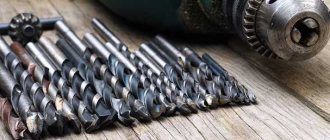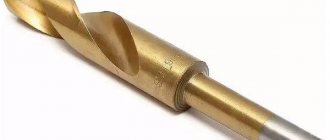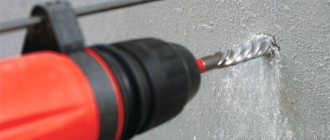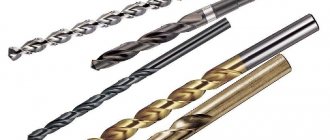From the author: Hello friends! To carry out repair and construction work, it is often necessary to drill into concrete and brick walls. Drills for metal surfaces are not suitable; they quickly begin to become dull and differ in the cutting part, quality and other features. Therefore, you need to know which drill bits for concrete are best, because there are quite a large number of their manufacturers.
Main types of concrete drills
A distinctive feature of a concrete drill from others is soldering. It is created from a strong alloy, due to which a hardness similar to diamond stones is achieved. Craftsmen call these types pobedit; these products differ in strength from other types that are created for metal or wood.
There are 2 main types by which concrete drills are classified:
- for a drill - consist of a shank for a nozzle, which is made in a cylindrical or multifaceted shape. The dimensions are small, the product is suitable for creating holes in many hard materials, for example, brick, foam block. It is recommended to use a high-power drill, which will allow you to drill into concrete,
- for a hammer drill - the drill is cylindrical in shape, has a shank, designations SDS PLUS or SDS MAX. The goods themselves are quite large and long, suitable for reinforced concrete structures.
If you need to create holes in a reinforced concrete structure using a simple drill, then it is not always possible to solve the problem with just a drill. You need to use a hammer drill, and for this tool, drills are divided into the following types:
- screw - used to create deep holes,
- spiral - suitable for large holes,
- flat - used for drilling passages of different sizes and depths.
For proper operation, you will need to not just insert the drill into the chuck, but snap it into place. To make this task easier, the products have a slight thickening at the very end. It should also be noted that the products are considered professional tools, since they can be used to create holes from 4 mm to 3 cm in diameter.
If you need a larger hole, then the crown type will come to the rescue. Such products make it possible to make a recess of 12 cm in diameter. The products are very durable and are produced in several versions:
- diamond - visually made in the form of a pipe or crown, mounted on a rod, the edges are coated with diamond, which ensures high strength,
- pobedit - similar to an attachment, the main difference from diamond is the absence of sputtering; it is replaced by special teeth made from pobedit.
It is recommended to use crown products for holes for sockets, switches or wiring, and other communications. To select a suitable concrete product for a drill, you will need to take into account not only the parameters of the element, but also the dimensions of the future hole. Based on this, the length of the drill is selected, which depends on the diameter:
- diameter 4 mm - length 5 cm,
- 5 mm - 10 cm,
- 6 mm - 15 cm,
- 8 mm - 25 cm,
- 10 mm - 54 cm,
- 12 mm or more - up to 100 cm.
It turns out that for large holes a long concrete drill is used. If you use thin instruments, there is a risk of damage due to increased load.
Best Inexpensive Drill Sets
Budget drills are presented with no less high-quality products, but, as a rule, in reduced configurations .
Makita D-00795
Using the SDS-plus Makita D-00795 kit, supplied in a convenient blister, you can quickly and easily make a hole of any diameter in concrete or masonry.
The presented set is equipped with five high-strength drills.
Each product is made of a special alloy and has an optimal centering tip geometry, guaranteeing accurate and fast drilling.
The convenient shank provides ease of installation, versatility and compatibility with many well-known hammer drills.
The dust removal spiral with four-groove thread ensures rapid removal of cuttings from the drilling zone. This technology speeds up and facilitates the work process.
Characteristics and equipment:
- working part - drill;
- shank - SDS-plus with a diameter of 10 mm;
- number of items in the set - 5;
- processed materials - concrete, brick;
- set of drills - 5×110/6×110/8×110/6×160/8×160 mm;
- Features: plastic blister packaging.
Advantages
- reasonable price;
- quality steel;
- there is lubricant from the factory;
- compactness for storage.
Flaws
- primitive packaging;
- limited selection of rooms;
- lack of long equipment in the set.
Metabo 626243000 160 mm
The SDS-plus Metabo 626243000 set with 160 mm long accessories is suitable for use in rotary hammers when drilling materials such as brick or concrete.
The drill bits used in the kit are the most common with guaranteed compatibility with most models of rotary hammers from different manufacturers.
The set contains five items - these are drills with a diameter of 5 to 10 mm.
The elements are made of high-quality steel, contain a tip made of hard alloys, which easily passes through dense materials and withstands long-term use.
The spiral is made in the shape of the letter S for faster removal of generated debris during drilling.
Characteristics and equipment:
- working part - drill;
- shank - SDS-plus with a diameter of 10 mm;
- number of items in the set - 5;
- processed materials - concrete, stone;
- set of drills - 5×160/6×160 ×2/8×160/10×160 mm;
- Features: plastic case for storing equipment.
Advantages
- ideal for domestic use;
- affordable price tag;
- high-quality equipment;
- Convenient case included.
Flaws
- no long drills;
- The case gets dirty quickly.
ELITECH 1820.036600
The SDS-plus ELITECH 1820.036600 set is ideal for making holes in concrete materials using a hammer drill with the appropriate type of fastening.
The presented kit is equipped with elements with an SDS-Plus shank - the most popular equipment base option, compatible with most modern rotary hammers.
The plastic case contains five drills with a diameter of 5 to 10 mm and a length of 110 and 160 mm.
The equipment is distinguished by excellent workmanship and a high degree of reliability.
Characteristics and equipment:
- working part - drill;
- shank - SDS-plus with a diameter of 10 mm;
- number of items in the set - 5;
- processed materials - concrete;
- set of drills - 5×110/6×110/6×160/8×160/10×160 mm;
- Features: Plastic storage case.
Advantages
- low price;
- main numbers in the set;
- there is a case for storing equipment;
- Ease of use.
Flaws
- The case cover is not very reliable;
- there is a smell of plastic;
- Medium length rigs only.
BOSCH 2608833912 160 mm
Using the SDS-plus BOSCH 2608833912 160 mm set, designed to work with concrete, brick or stone in hammer drilling mode, the user will be able to make clean and neat holes in dense materials.
Drills of the same length have diameters of 6, 8 and 10 mm.
The equipment is suitable for construction, finishing and installation work.
Suitable for use in household and professional hammer drill models.
Three complete products are placed in plastic packaging.
The SDS-Plus type shank guarantees reliable fixation in the power tool chuck.
The spiral-shaped working part of each drill effectively removes dust from the hole being made and does not heat up during operation.
Characteristics and equipment:
- working part - drill;
- shank - SDS-plus with a diameter of 10 mm;
- number of items in the set - 3;
- processed materials - concrete, brick, stone;
- set of drills - 6×160/8×160/10×160 mm;
- Features: plastic packaging, centering tip.
Advantages
- ease of drilling even with a weak impact;
- the most common drill diameters included;
- high quality of materials and workmanship;
- price corresponding to quality.
Flaws
- no case included;
- The packaging is poorly suited for storing equipment.
Features of drills
In order to choose the right drill for concrete structures, without making mistakes, you will need to know the features that distinguish them from products for metal and other materials.
The shape of the working area will be quite blunt; this area is made of a Pobedit plate. This type is suitable for concrete as woodworking products will include sharp tips. Due to this, at the beginning of the work, the wood is stuck inside, and only then a hole is made. The working area of a metal product is similar to a cone with no sharp points.
The color of concrete products is often metallic white. Products for wood will be strictly metal, and for metal, black colors are used.
Concrete drill bits for drills - what and how best to drill
Comparing different types of tools, you can see that they have visible differences. Those used for drilling monoliths have a pobedite head installed. It is made of high strength metal. Pobedit allows you to drill concrete slabs and rocks.
Products with a reinforced head are used to process monolithic concrete slabs, metal, wood and other materials. The purpose can be determined by the color of the tip. White color is provided for concrete treatment. Black is used for drilling in metal, and a light shade of metallic color is used for drilling in wood.
If they are doing one-time repairs in an apartment, then they choose a tool at a more affordable price. During professional work, the need to work with this tool often arises, so purchasing well-made units is more important. At the same time, it is profitable to buy a set. Each part in such a set is purchased at a lower price.
Drilling Tips
There are a few simple rules to follow when drilling into concrete. Due to this, the work is performed more efficiently, and the service life of the product increases:
- When you first experience drilling concrete with a drill, you need to prepare several types of drills, you can even reserve them for metal. This is due to the fact that each type has its own purpose - for example, some are suitable for brick, while others are suitable for concrete and ceramics. When creating holes in the wall, there is a possibility that metal reinforcement will appear along the way, in which case the drill is changed and work continues,
- Some people specifically sharpen a concrete drill bit, so they can drill into metal during the job. This decision is wrong, since for the versatility of the product you will need to know many sharpening rules and have a lot of experience,
- It is forbidden to work without breaks; if the drill overheats, it may be damaged. It is recommended to drill for 15 seconds and then leave the drill to cool down. Do not use water or other mixtures for rapid cooling,
- Concrete always contains solid fractions in the form of stones, which can stop the drill during operation. It is easy to crush such inclusions with a chipper, and then continue to create a hole,
- if a hole needs to be made in a concrete wall, which is a load-bearing wall, or in ceilings, then it is better to use a hammer drill. Thanks to it, work is performed more efficiently and quickly,
- It is necessary to drill ceramics on walls or floors without the impact mode of the drill, otherwise the materials will be destroyed. Ceramic surfaces should only be worked with concrete drills,
- Cheap concrete drills are made from low-quality alloy, so they are not hard and need to be sharpened from time to time. To do this, you can use an angle grinder and a diamond disc,
- While drilling, it is not recommended to put pressure on the drill; this causes loss of balance, and drilling becomes more difficult. In addition, there is a possibility of the drill breaking, it simply bursts,
- To make holes for plastic dowels, it is recommended to make the depth a little larger. Dust and other dirt will not allow you to place the element correctly, a reserve is simply necessary,
- You need to start drilling concrete with low drill speeds so that the drill does not jump and the hole is smooth. After reaching a certain depth, the speed increases or the tool switches to impact mode,
- If the drill is used very often and for a long time, then you need to replace the chuck. Over the years, the fixation weakens, so the quality of work decreases, there is a risk of injury,
- When drilling, experts recommend soaking the drill in cold water, but not cooling it using this method. This rule protects the product from damage,
- To maintain cleanliness while working, it is recommended to put a plastic cup on the drill. This protects against flying concrete dust,
- Do not hold or hold the chuck with your hands while the drill is operating. You can only hold on to the body,
- When using gloves and protective clothing, it is important to use the correct size to avoid getting caught in the cartridge. Additionally, it is recommended to wear glasses to protect your eyes from dust.
When working according to the rules and using these tips, drilling concrete will be a simple and safe task, and the drills will last a long time.
The best Forstner drills for wood
Blind holes in wood for mounting hinges and various fittings are made using a Forstner wood drill with cutting edges on the side plane. The tool is designed for work that requires high precision. Forstner equipment does not heat up during drilling and can be used to solve professional problems. Experts recommend two brands, which have a good resource and can be used to perform important work in a furniture workshop.
Dewalt DT4590-QZ
The equipment is made of high quality high-speed steel. The centering drill simplifies the work, allows you to accurately select the location for drilling and securely fixes the tool, protecting it from displacement. The cutting edges have an effective sharpening angle, which ensures accurate drilling and the necessary accuracy.
The cutting tool works well with dry wood, chipboard and plywood. The cylindrical shank makes the equipment universal and allows use with any type of chuck. The working length of 87 mm makes it convenient to process workpieces of large thickness.
Advantages:
- Increased service life;
- Does not require additional sharpening;
- No runout;
- Good efficiency at high speed.
Flaws:
- Overcharge.
Metabo Forstner 627594000
The equipment of the German company is made of high-speed tool steel. The main purpose is to drill blind holes with even and smooth walls. The design has two ring and two main cutting edges, which ensure impeccable processing quality. A centering point is used for precise positioning on wood parts. The cylindrical shank is securely fixed in any type of chuck.
The tool is designed for processing hard and soft wood, chipboard and plywood. Gently handles laminated surfaces without chipping edges. A working length of 90 mm makes it easy to work with thick workpieces.
Advantages:
- No runout;
- Good sharpening quality;
- Competent design of the centering spike;
- Increased resource;
- Don't be dumb.
Flaws:
- High price.
Sharpening
When drilling concrete surfaces, sooner or later there is a need to sharpen the working part, even if it is made of diamond or coated with diamond. For the procedure you will need to use a sharpener or a special machine. In addition, at home you can use a regular universal machine or sharpen attachments with a grinder.
It is important to inspect the drill tip before doing any work. It should have 2 “shelves” that are the same length. Otherwise, damage will occur during drilling, and the holes themselves will be of poor quality. The whole sharpening process is not complicated, the main thing is to ensure the evenness of the shelves:
- for concrete and other hard materials, the alpha angle is 200–300,
- the cutting edges must not touch the grinding wheel, otherwise there is a risk of breakage,
- When sharpening, it is forbidden to bring the drills to heat; from time to time you need to pause and cool the material; the use of water is allowed. If the working part is hot, then it must be left to cool in the usual way, since contact with water risks cracking the drill.
Sharpening a drill for concrete is a complex process that requires certain skills, so without knowledge it is better to turn to the experts.
Correct selection of drills
The main criterion will be the choice of drill according to the chuck. Depending on the hammer drill chuck, the drill is also selected, because another type simply will not work.
After this, you need to choose the required size. When choosing a drill, choose a size that is slightly smaller than the required hole. This is due to the fact that when the hammer drill operates, an error is created, which crushes the concrete (and other elements) around the circumference as the drill moves. The assortment on the market is very large, so it will not be difficult to choose a smaller one.
The third thing you need to pay attention to is the length. It's a matter of the depth of the required hole, and the assortment allows you to find what you need.
But long drills with half a meter and a diameter the size of a match simply do not exist - as the length increases, small diameters are discarded and vice versa.
Review of manufacturers
Drills that are used for concrete are produced by both domestic and foreign companies. The cost largely depends on the country of origin. The high price of the product is justified, since all types of concrete products are characterized by a long service life and improved quality. It is very difficult to say exactly which is the best concrete drill bit for a drill. Among the leaders from foreign brands are:
- Makita - precision drills with unusual brazing. While working, it is easy to create smooth and clear holes of different sizes, but more often they are shallow,
- Bosch is the most popular company producing equipment and materials for repairs and construction. The drills have a four-spiral working surface. This ensures maximum performance and minimum friction. Often used for drilling concrete of any density and creating deep holes,
- Diager Twister is a company that is distinguished by its high reliability and high-quality product. Drills are used for both concrete, brick, and other stones. The assortment is very large, there are drills for drills, hammer drills and other tools,
- Metabo and Staver .
The companies described produce high-quality products, but they are expensive. Among domestic companies and manufacturers from the CIS and China, it is necessary to highlight:
- Bison are the most common drills from domestic manufacturers. The company offers a large assortment at an affordable price with good quality,
- Interskol,
- Anchor,
- Hurricane.
Chinese drills can be quite good and reliable, but they cost more than usual. It is worth understanding that high-quality goods cannot be cheap, since only the best raw materials and new technologies are used for their production. To make the right choice, it is recommended to watch the video:
Products with low cost may be made from a poor alloy, or made in violation of the technological process. There are many fakes that are almost no different from the original. Craftsmen claim that a fake is always darker in color, since some of the stages during casting are skipped or disrupted. To save money, it is better to buy drills in a set rather than individually.
Parameters and varieties
The main feature of the concrete tool is that its working element has special soldering tips made of a special alloy with the highest level of hardness. Thanks to its excellent performance properties, this metal alloy received the interesting name “win.” Parts made from it are considered the most suitable tool designed for the full processing of this material.
This type of instrument comes in several categories:
- products with a polyhedron or cylinder design;
- a tool with a hammer drill and a cylindrical “tail”.
Many home craftsmen often have questions related to the choice of tools and equipment for processing reinforced concrete structures. To solve this problem, you can use a hammer drill and elements designed for an impact drill. This type of detail comes in three types:
- Screw products. They are used for drilling deep holes.
- Spiral tool. With its help, holes with a large diameter are made.
- Sloping elements that allow you to create holes of small depth and diameter.
Thanks to the thickening in the tail area, the drill bits are very easy to install into the drill chuck by simply snapping them into place. Devices for processing concrete are usually selected by installation experts and builders.
In this situation, if you need to get a large hole, you often use a core tool. Such drills allow you to make holes with a diameter of up to twelve centimeters. Core drills for concrete come in several types:
- diamond drills for concrete in the form of a crown or tube, fixed on a rod;
- Pobedit drills for concrete, which are characterized by a design similar to a diamond tool (they differ from their diamond counterparts in the material from which the teeth of the cutting surface are made).
The need to use a core drill appears in situations where it is necessary to prepare mounting holes for switches and electrical sockets, extend communications and perform other work that is related to the creation of recesses and large-sized holes.
The choice of a suitable drill depends on the depth and diameter of the intended holes.











